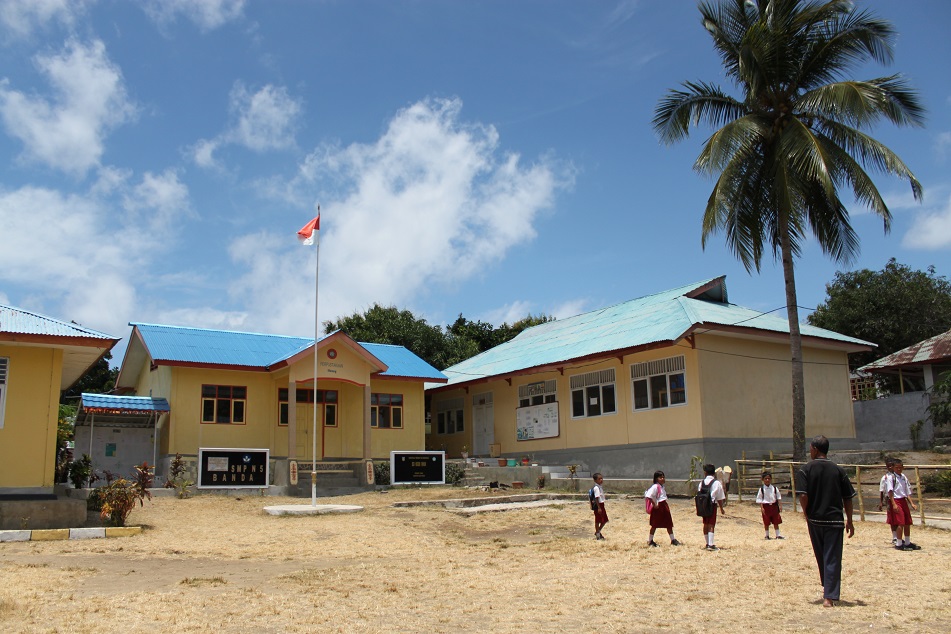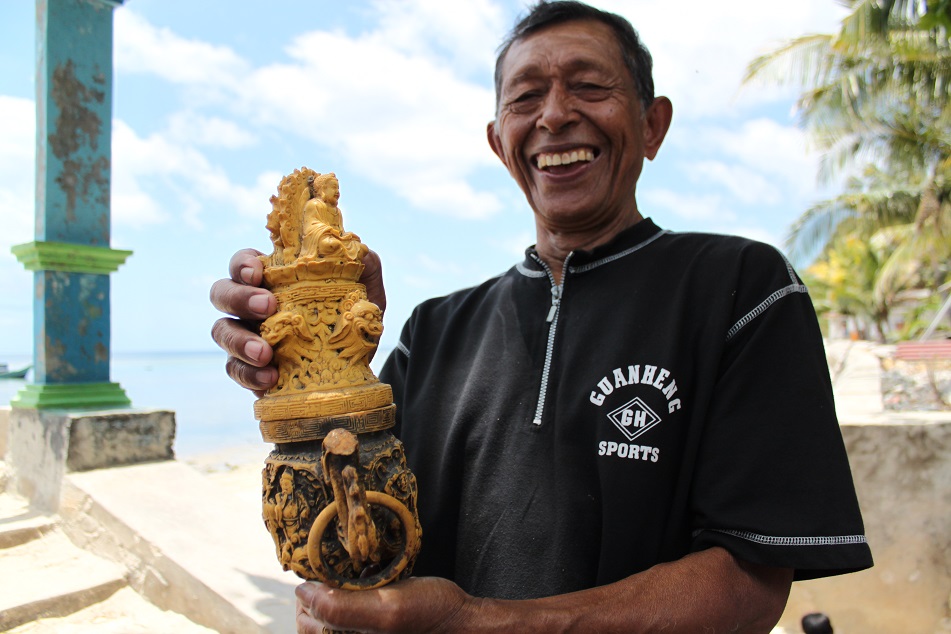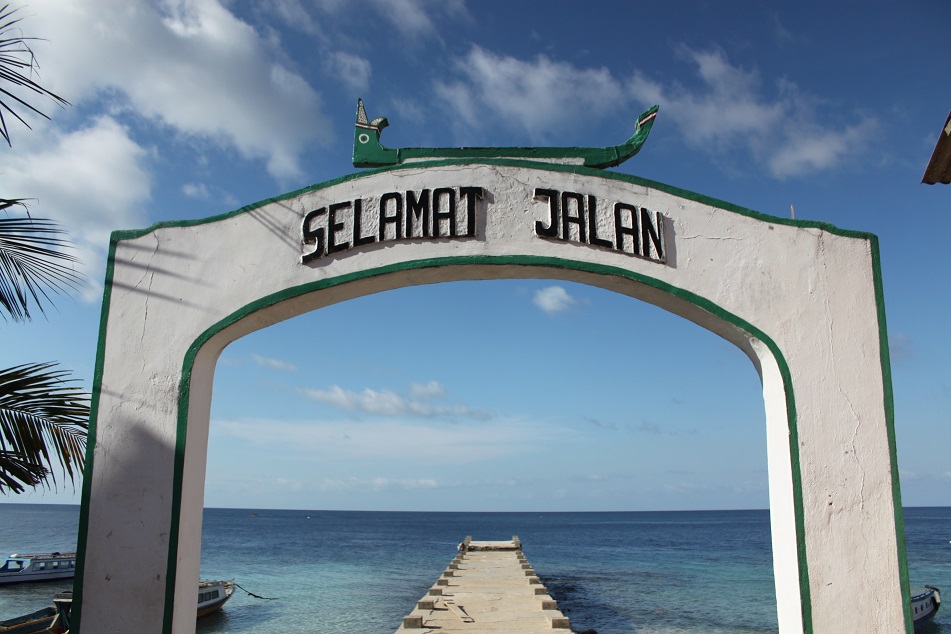Chapter 4, Part 8
Among the remote islands of the Bandas, Run (Rhun) is situated at the westernmost corner of the chain, some two hours away by a small boat from Banda Neira – the most populated of the Banda Islands. Like its sisters to the east, until the 19th century Run was one of the only places in the world where nutmeg trees grew. Highly sought after by Europeans, nutmeg was valued as much as 320 times its original price once it reached Amsterdam.
As a response to the lucrative spice trade, European explorers and merchants scoured the oceans to find direct sea routes to the fabled Spice Islands. Spearheaded by the Portuguese and the Spanish, other European nations soon followed, including the Dutch, the English, the French and the Danish. In 1600 the East India Company (EIC) was established in London to strengthen the English trade in the East Indies (modern-day Southeast Asia). Two years later the Dutch launched the Dutch East India Company (VOC) to rival the EIC, and soon the centuries-long fierce competition between the two began to escalate.
In 1603, the English reached the Banda Islands for the first time and made contact with the people of Run. This happened at a time when the VOC’s dominance in the nutmeg trade started to grow, by way of imposing a trade monopoly across the Bandas and procuring nutmeg from local producers at very low prices. Captain Nathaniel Courthope, who was sent by the EIC a few years earlier to reach the Bandas, arrived at Run in 1616. The locals saw the English as a more favorable trading partner compared to the Dutch as the former was willing to buy nutmeg at a higher price.
On the island of Run, Courthope managed to persuade the local people to acknowledge England’s sovereignty over the island in return for the premium price the English paid. Such an agreement effectively made Run the world’s first ever English colony. Nevertheless, due to the strong presence of the Dutch in the Banda Islands, the English were forced to retreat in 1620 despite having built fortifications on Run and the nearby island of Nailaka. Since then England maintained its claim over Run even though the Dutch were the de facto rulers of the island. This led to a series of treaties resulting in England’s insistence that Run must be returned to them.
Meanwhile, on the other side of the world, competition between the English and the Dutch also flared up.
Following the rediscovery of America by Christopher Columbus, waves of European immigrants arrived on the eastern coast of America and established settlements to support their trade interests. The New England Confederation was formed in a region which is part of modern-day Massachusetts, Connecticut and Rhode Island, meanwhile New Sweden was established along the banks of Delaware River. In between the two colonies, New Netherland occupied the areas around present-day Manhattan and the Hudson River.
The relentless enmity between the English and the Dutch resulted in the Anglo-Dutch wars. In 1664, the English captured New Amsterdam on the island of Manhattan and renamed it New York. Three years later a treaty was signed in the Dutch city of Breda to end the second Anglo-Dutch War, with both sides agreeing to relinquish their claims of places already effectively administered by the other side. In this respect, the English kept the island of Manhattan and the Dutch formally retook control of Run. Subsequent wars were fought among the English and the Dutch for over a century, including in a period of history when the Netherlands was a vassal state of Napoleonic France. But after the introduction of nutmeg trees in several British overseas possessions in the 19th century, the Bandas no longer enjoyed a prominent status in the global spice trade.
To the east of Run, the island of Ai (Ay), situated midway between Run and Banda Neira, saw bloody battles between the Dutch and the English. In 1615 the Dutch attacked Ai which at that time was briefly controlled by the English. But that very night the English launched a surprise attack against the Dutch. A year later the Dutch returned to Ai for another attempt to take the island, this time with a bigger force. After a month of bombardment, the English eventually conceded defeat and retreated from Ai. The Dutch later strengthened a fort on the island and renamed it Fort Revenge.
Today, life in Ai is not so different from the other Banda Islands. The island was very peaceful and laid back when I went, albeit with notable distinctions I didn’t see on the other islands. A no-catch and no-swim zone was imposed on the northwestern coast of the island as an effort to preserve the coral reefs and fish there. A sasi (a local customary ban on taking and consuming certain animals or plants) was in force upon four marine species: lobster, sea cucumber, commercial top shell, and green turban to ensure their healthy numbers around the island.
Ai was also where I witnessed how a local man called Djakaria started an initiative to reduce plastic bottle waste on the island. He encouraged the local kids to collect bottles around the island and take them to a ‘waste bank’. Then books or clothes would be given to them as a reward, hoping that this would instill the awareness of the importance of keeping the environment clean from early age. The entrance fee paid by all visitors to the island was used to provide the incentives for the kids.
The distance between Run and Ai is roughly the same as the distance from Manhattan to Staten Island. But the difference between the two parts of the world could not have been starker. New York City is now the center of the global economy, while the Banda Islands has long bid adieu to the ships from faraway lands that once flocked to its waters. Our small boat left Ai for Banda Neira with dozens of dolphins swimming not far from us. Such is the typical hustle and bustle in the Bandas, a silent witness of a dramatic turn in world history.
Click here for the full list of stories from the Spice Odyssey series.


















By the looks of it, I wanna go through the computer screen to get there.
LikeLiked by 1 person
Oh I so want to do that too now! 🙂 The Banda Islands really is one of the most beautiful and fascinating places in Indonesia. Thanks for dropping by!
LikeLiked by 1 person
look so good
LikeLiked by 1 person
It’s far and remote, but it was really worth the long journey.
LikeLike
Stunning photography and storytelling as always!
LikeLiked by 1 person
Thanks Nicole! Isn’t it fascinating that a small island in the remote corner of Indonesia has a historical connection with Manhattan?
LikeLiked by 1 person
Yes it is!
LikeLiked by 1 person
Learning the twists and turns of history that were never in our school books is always so interesting. Thanks for the time you take to do the research! I had never heard of New Sweden.
I would take life on Run over that on Manhattan any day!
LikeLiked by 1 person
Indeed, Marilyn. I believe there are more interesting twists and turns of history for us to learn. Run was a very peaceful and idyllic island — perfect for those who wish to escape the hustle and bustle of places like Manhattan. 🙂
LikeLike
I recently began to follow your blog. My first impression is that your posts are by far a cut above the rest. The images are superb and the writing introduces us to interesting and not very well known events of world history. Thank you for sharing your travel experiences with us!
LikeLiked by 1 person
Always appreciate your comment, Peter. It’s very encouraging to know that people from places far away from where I live actually read my blog and enjoy my photos. Blogging really is a window to some of the most unique corners of the world. Thanks again!
LikeLiked by 1 person
Incredible scenery there. And I love the fact that it is not touristic yet.
LikeLiked by 1 person
Hi Hector. Thanks to its remoteness, the Banda Islands remains largely devoid of hordes of tourists — a fact that I believe won’t change in the near future.
LikeLike
That is quite an incredible artifact! Do you know what it was made of and what it is?
LikeLiked by 1 person
I honestly have no idea what that is. It looks Chinese though, but I can’t tell from which period of history it was made.
LikeLiked by 1 person
Infonya sangat berguna .. Kemaren saya ada liat kuis hexagon war di salah satu stasiun tv kita, menanyakan manhattan ditukar dengan pulau di propinsi apa.. banyak yang gak tauu…. huhu..
LikeLiked by 1 person
Sayang sih memang fakta sejarah semenarik itu banyak gak diketahui sama masyarakat kita sendiri. Tapi seinget saya memang hal ini gak diajarkan di buku pelajaran sejarah di sekolah sih.
LikeLiked by 1 person
That is interesting about the trash banks. I have heard of those in different parts of Indonesia and it seems like a great way to encourage clean up and recycling. I really like that last photo.
LikeLiked by 1 person
Initiatives like this grow as a result of the inability of many local governments to take care of some of the basic needs of the people, including waste management. I like that photo too — it’s as if trying to tell people that beyond their small island lies a vast ocean to explore. Thanks Jeff!
LikeLike
Yes trying to crawl through the computer screen for sure. Indonesia really has been on my mind. You are definitely inspiring wanderlust Bama.
LikeLiked by 1 person
I’m glad this post makes you feel that way, Sue. 🙂 If only I could teleport myself to Canada and you to Indonesia.
LikeLiked by 1 person
Bama that sounds like a perfect exchange program!
LikeLiked by 1 person
A fascinating story!
LikeLiked by 1 person
I really appreciate your time reading this post! Thanks.
LikeLike
I started reading just to figure out what the title meant, but was rewarded with much more – a luscious-looking island, good news on plastic bottle pick-up, and that fascinating tidbit about the island trade!
LikeLiked by 1 person
I wonder if people think of the marathon or some kind of charity event when they read the title. 🙂 A remote place like the Banda Islands do need creative ways to deal with the garbage — it was very encouraging to know that some of the locals started those initiatives. Thanks for reading, Lex.
LikeLiked by 1 person
Yes! I did think Run was a verb and that you had suddenly moved on to other parts of the world! Maybe they should organize a Run for Run to raise money for that garbage initiative!
LikeLiked by 1 person
Run for Run sounds very interesting and easy to remember. The thing about such initiative is probably we need so many races since in general public awareness of the importance of proper waster management in Indonesia is still very low. But it has to start sooner than later.
LikeLiked by 1 person
The photos look amazing!
LikeLiked by 1 person
Thanks! Really appreciate your kind words.
LikeLike
I never knew such a magnificent place existed! Thanks for sharing your travel experience and some information about world history with us. And by the way fantastic pictures. 🙂
LikeLiked by 1 person
And thank you for reading, Ratheesh. Really appreciate your kind comment.
LikeLike
This is so cool. Where exactly is this place? Still nggak ngudeng.#Penasaran
Oia, salam kenal mas, saya dari Pekanbaru masih terhitung newbie di blogger.
LikeLiked by 1 person
Hi Sarah, salam kenal juga. Pulau Run ini adalah bagian dari Kepulauan Banda yang terletak di Maluku.
LikeLike
Pingback: The Faces of Banda | What an Amazing World!
Well Bama, as you know it was the improbable real-life story of this “island swap” that first planted the seed of an idea – that someday we’d visit the Bandas. So to step ashore at Run and Ai, to experience these places firsthand, was simply unforgettable. Thanks for transporting me there through your wonderful photos, and as usual for the fascinating historical background.
LikeLike
That’s true, James. I wish Torben and Fiona could join us too. It was actually quite surreal to think of the island swap, and not just any ordinary island, it was Manhattan! I believe this part of world history is largely unknown even to most Indonesians.
LikeLiked by 1 person
Pingback: The Chinese Connection | What an Amazing World!